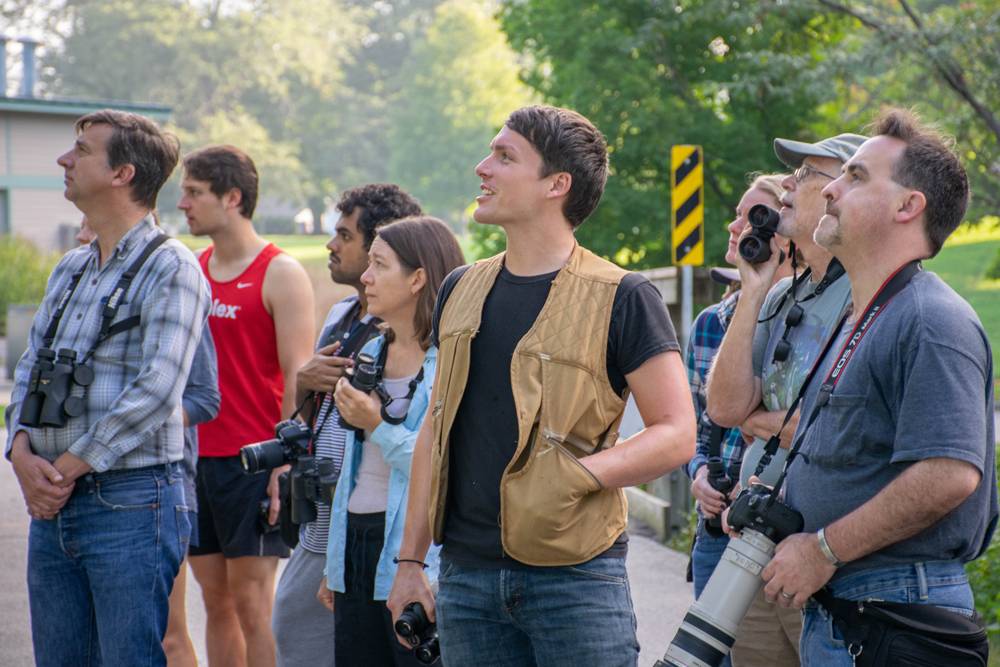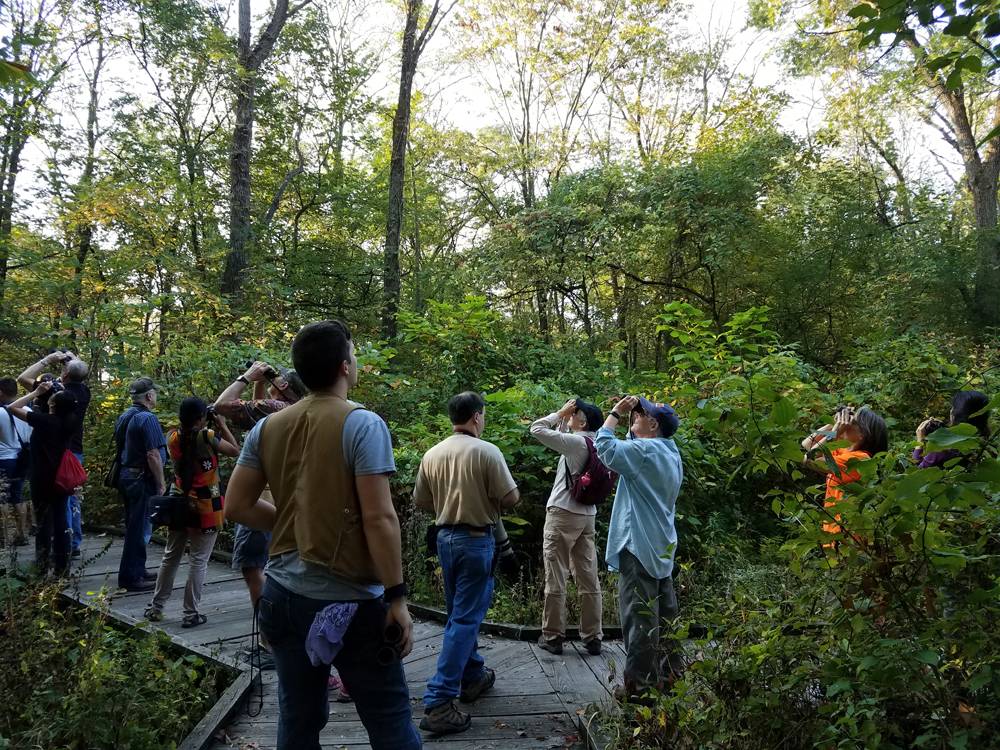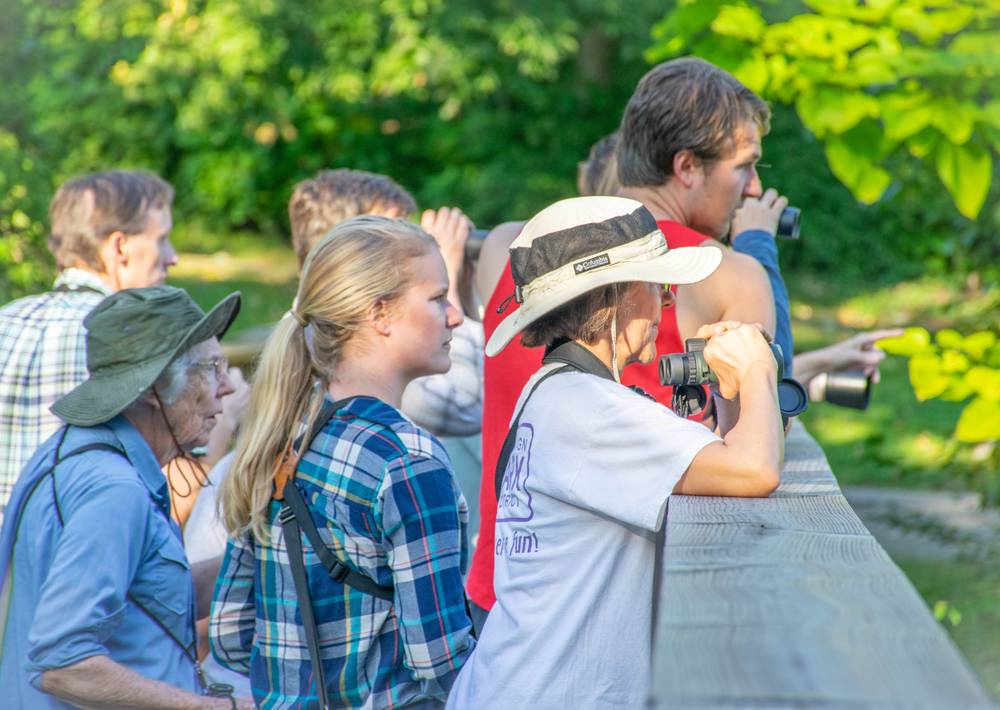Over the past several weeks, I’ve spent a lot of time thinking about birds. Spending so much time at thome, I’ve become more sensitive to the various bird calls and songs in my yard and neighborhood. Noticing the noise has led me to notice the creatures making the noise, and then I was Googling terrible descriptions of birds and their calls.
I’ve been thinking about birding in a different way after reading about the threats of violence made against Christian Cooper, a Black birder in New York City. What is C-U’s birding community about? Who is involved? What sort of programs do they offer? To answer these questions, I emailed with Brody Dunn, the President of the Champaign County Audubon Society.
Our interview was conducted via email. It has been edited for clarity and length.

Brody Dunn, in the tan vest. Photo by Jen Redwood.
Smile Politely: What is an Audubon society and what does it do?
Brody Dunn: It’s a birding and bird conservation non-profit funded by membership donations at the national and at the local level. National tends to do a lot of conservation lobbying and research grant funding. As for what we’re doing at a local level, In a normal year we’d be offering bird walks, funding education grants for local school teachers, and distributing money for scientific research, conservation, and outreach projects.
SP: Who is an Audubon society — and CCAS — for?
Dunn: Audubon is for anybody who likes birds, birding, nature, or conservation. Our local membership includes everyone from middle school kids to computer programmers and chemists.
SP: I’m thinking specifically about Amy Cooper’s threat against Christian Cooper in NYC’s Central Park several weeks ago. What is CCAS doing to encourage Black and Brown people to participate?
Dunn: Something a friend has had to remind me of — several times — is that Chris Cooper is Black man, who happened to be birding, who experienced an obscene act of racism. He wasn’t a birder who just happened to be Black. The discrimination had everything to do with his Blackness and little to do with his having been birding. This isn’t to say that Black birders don’t experience racism uniquely because of that addition to their identity (they do), or that there is no racism in the birding community (there certainly is), just that Chris Cooper’s experience was outrageous because of the crime done against his Black person, not his binoculars.
With that said, we have been in the process of changing our events and priorities to reflect our own failing of the Black and Brown communities in Champaign County. We changed how our education grant system works to make it more forgiving to first time applicants, we added some rules to our bird walk script to make it obvious that the bird walk leader is an ally to diverse birders, and we’re currently in talks with the Douglass Branch of the Champaign Public Library about offering an after-school birding program.
SP: What are some of the programs that CCAS provides?
Dunn: Under normal circumstances we’d be offering bird walks, speaking events, children’s programs, new birder programs, and a ton of other things. Because of COVID-19 we’ve unfortunately shut down nearly everything. We’re hoping we will be able to offer some limited public events this fall.

Photo by Rachel Vinsel.
SP: What is a Sunday morning bird walk like?
Dunn: The public Sunday walks are a blast! We start in the Anita Purves Nature Center at 7:30 a.m. each Sunday, March through May, and September and October. I give a little introduction, ask if anyone needs to borrow a pair of binoculars, and we take a walk through Crystal Lake Park or Busey Woods looking for birds together. I point out birds and bird calls, idenitify them, and help everyone get focused on it so they can see or hear it for themselves. The crowd averages 25-30 people. It’s free and open to the public.
SP: How did you become interested in birding?
Dunn: A wood thrush at Allerton Park absolutely enchanted me once, but I think what really got me interested was my environmental writing professor in undergrad. He’d go on tangents about birds and birding, and his obvious passion got me convinced I needed a pair of [binoculars] for myself. I’ve been birding ever since and I still find the wood thrush enchanting.
SP: How did you find your way to CCAS and how long have you been president of the board?
Dunn: I’d love to say that I was selected to be on the board because of my degree in environmental sustainability, my history working in conservation, or my ability to identify tricky birds, but the board brought me on simply because I wanted to do some good for Champaign birds and Champaign birders. As for the route I took to get here, I started out as a Member-at-Large (I represented CCAS membership), and went on to become Vice President and then President. This is my second year as CCAS president.
SP: This might sound a little silly…but it’s been my observation that older people tend to be into birding. Have you also made that observation?
Dunn: Our age demographics were something I focused on a lot when I first started at CCAS. It’s absolutely the case that our membership trends older, but that’s a little less true every year. Young people have really been getting into birding and it’s been fantastic seeing high school and college students attend our events. My favorites have been the few middle-school kids who dragged their parents to the walks. The parents always seem reluctant but get super into it after a few Sundays.
SP: I have found, as I’ve gotten older, I’m also more aware or interested in the types of birds I see. Is this some sort of world-weariness that manifests as people wanting to take in nature as an escape? What do you think?
Dunn: Regardless of its origin, aging or otherwise, I do think it’s common to find escape from disillusionment and weariness in birding. Birds are all around us, even in the biggest city. It’s so lovely to get pulled out of your day unexpectedly by a bird call or to lose yourself in the act of birding at a park, even if you don’t find any exciting birds there.
SP: Where can one go birding around Champaign County? Are some spots better than others, and are there ideal times of year to go?
Dunn: The place I go the most are Crystal Lake Park and Busey Woods in Urbana. They’re pretty much unparalleled in terms of bird diversity and human accessibility. River Bend out in Mahomet is also great. If you’re willing to drive for a bit, Allerton Park in Piatt County is wonderful, too. As for time of year, I always tell new birders to start birding now, regardless of when “now” is. Every season has advantages and disadvantages, but none of them will disappoint you.
SP: What are some of the most sought after or exciting birds to see here in Central Illinois?
Dunn: That’s actually a very funny question. There’s an entire infrastructure built up to alert birders about rare birds in their area. Champaign County gets quite a few wanderers and they always attract a rush of birders trying to get eyes on them. Everything from snowy owls to whooping cranes have been seen in the last few years.
Generally speaking though, the biggest and most exciting scene in Champaign [County] is probably the unbelievable diversity and density of warblers that travel through Busey Woods and Crystal Lake Park during spring and fall migration.
SP: What are your bucket list birds?
Dunn: I love, or am at least very curious about, birds that have naturally shifting territories. The painted bunting, cattle egret, fish crow, and black vulture have all been expanding northward year after year, but very slowly and in a manner that suggests they aren’t necessarily invasive. I’d love to see them!
SP: How can people get involved?
Dunn: Join Champaign County Audubon! There’s a membership link on our website.
Alternatively, you can keep an eye on our social media (Facebook and Twitter) to see if we will be offering the Sunday Walks in the fall. They are open to the public and free.








